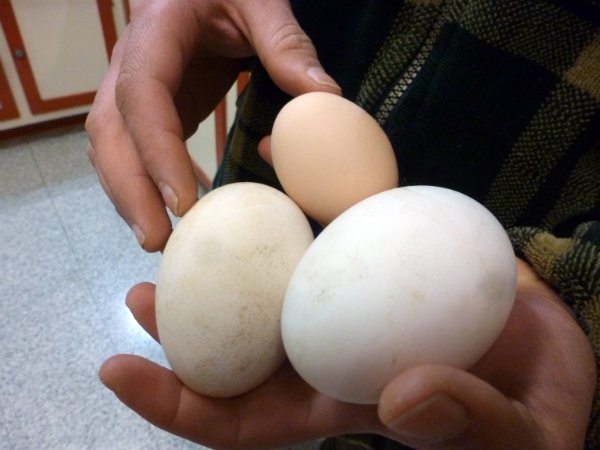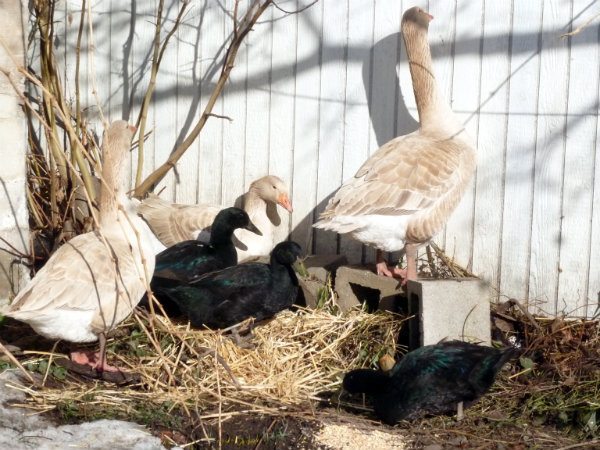
Last week our littlest goose started hanging out in a corner of the yard – literally a corner between a fence, a shed, two cinderblock bricks and a weed tree. There was hardly enough space for her to rest peacefully. We watched her turn in different directions and settle only to rise and turn again. But she seemed determined. The other two geese stood like sentries on either side of her as she grasped at grass and straw and vines to tuck around her. She made a new noise, sort of a whining, crying sound.
When the threesome abandoned the corner Ben and I investigated. We found two eggs, each the size of three chicken eggs. Ben threw straw near the nest to give her material to work with. Then, we collected the eggs.
She’s laying right on time. Young geese don’t lay their first eggs until their first full spring. We got our birds in late-March of 2012, so it’s perfect timing for her to start laying eggs now that spring is here.
This new phase of goose life raises lots of questions. How should we help our female nest? How much protection does she need? When will the eggs become viable? How should they be incubated? Are they even fertilized?
 The two goose eggs (left and right) dwarf a chicken egg.
The two goose eggs (left and right) dwarf a chicken egg.
As to that last question, we’ve read that geese prefer to mate on water. With the spring thaw, we’re able to more easily fill the birds’ kiddie pool for them to bathe in. This morning, while we were out doing our morning poultry chores, all three geese got into the pool together and we saw the Protester mount the goose. It looked kind of violent. He was yanking on the feathers on the back of her head — apparently a goose who’s been the subject of a gander’s sexual urges will often be missing a bunch of feathers on the back of her head. So there’s a some chance her next few eggs may be fertilized, but as Ben has mentioned, those eggs could contain some muddied goose genetics.
 The fowl family gathers around the mother-to-be. For whatever reason, the Protester found it necessary to climb up on a cinder block to better survey the side of the garage for potential threats. Luckily, none materialized out of the whitewashed paneling.
The fowl family gathers around the mother-to-be. For whatever reason, the Protester found it necessary to climb up on a cinder block to better survey the side of the garage for potential threats. Luckily, none materialized out of the whitewashed paneling.
Ben had noticed before that the goose had a bald patch on her down-feathered chest. Geese often pull out their down feathers to make a nice, soft, warm nest to lay eggs on.
Two of her three eggs now reside in our fridge. We do not believe they are fertilized, but we also read that the first half dozen eggs of a goose are rarely viable. We may as well eat them.
 A goose egg in a vernal nest (Not pictured: A second egg hidden beneath a duff of straw, twigs and leaves that initially escaped our attention as well.)
A goose egg in a vernal nest (Not pictured: A second egg hidden beneath a duff of straw, twigs and leaves that initially escaped our attention as well.)
One egg, partially as an experiment, rests under Mama Cass, our old Barred-Rock hen. Mama came up lame the other day, perhaps a cat attack. She now occupies the sick bird box in our kitchen – formerly home of Bumblefoot/Cricket. Because she cannot walk she has become our incubator. Brooding chickens will hatch any egg under them. Mama, despite her advanced age, started laying her great big eggs again this spring, as thin-shelled and delicious as ever. But she’s stopped laying since being confined to the kitchen box and sitting on the oversized egg. I think she will make a good surrogate mother should we need her.
 Mama Cass sat the goose egg while she was confined to the rehab box. (Photo credit: Brice Portolano)
Mama Cass sat the goose egg while she was confined to the rehab box. (Photo credit: Brice Portolano)
Ideally, the female goose will raise her own young. We need to make her comfortable, maybe build a little house over the nest site is in her future. With enough eggs on the nest she should start sitting full-time. The next few weeks will tell if she is a mother up to the task.
 The Hisser (left) and the Protester (right) have taken it upon themselves to act as sentries whenever the goose sets on her nest.
The Hisser (left) and the Protester (right) have taken it upon themselves to act as sentries whenever the goose sets on her nest.
